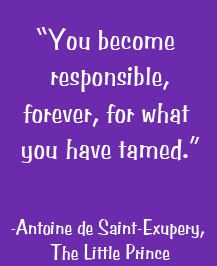- Written by: Deb White
- Category: Mental Stimulation
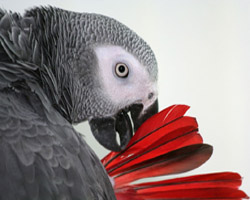 In the wild, parrots are challenged mentally every day just in their quest to find food and avoid predators as well as in their interactions with their flock mates.
In the wild, parrots are challenged mentally every day just in their quest to find food and avoid predators as well as in their interactions with their flock mates.
In nature, food is rarely available in such quantity that a parrot can satisfy it's needs without expending considerable effort. To be efficient and productive it requires planning and skills. Foraging requires the ability to recall locations of prime foraging sites. Birds rely on memory and positional mapping skills so they can head to foraging areas where food is available, rather than aimlessly searching around.
They also have to be able to interpret environmental cues and have a sense of seasonal timing to insure the food is ripe and ready for the taking. Once the food is found, they often have to be able to open and retrieve the food from within tough shells or fruit pods.
Predator avoidance also requires heightened mental awareness and finely tuned senses. Parrots have to be able to quickly process visual and auditory data in order to escape being another animal's dinner.
In general, the smarter an animal is, the more likely they are to have a social nature. Participation within a flock and social interactions require a different set of abilities such as the ability to recognize individual members of the flock, the ability to communicate, play and participate in cooperative behaviors.
Contrast a parrot's natural existence with one in captivity where they sit behind bars most of the day without the opportunity for exercise, interaction, or even "jobs" to do and where once a day clean "fast food" and water is delivered. This scenario has lead many birds to a very unhealthy and unhappy existence characterized by a host of behavioral issues (screaming, feather destruction, aggressiveness).
Do you want a Brainiac or a Maniac?
The more intelligent a being is, the more environmental and behavioral enrichment is requisite to their well-being. Parrots have been described as having the intellectual capacity of a 3-5 year old child. For more information on the intellectual abilities of birds check out our article: The Amazing Bird Brain.
With this recognition of their intellectual capacity, it's is imperative that bird owners take action to meet their need for daily mental stimulation. This can be accomplished by affording them with new opportunities for exploration as well as exposure to new situations and new people. Specific suggestions include:
- Providing a wide variety of toys including
- foraging toys
- destructible toys
- puzzle/manipulative toys
- teach & learn toys
- Rotating and changing out toys weekly.
- Playing interactive games with your bird.
- Introducing new foods in new ways.
- Training birds to learn new words, phrases and songs.
- Talking to your birds in context.
- Training your bird to do tricks.
- Introducing your bird to new environments and people by taking your bird on outings.
If you think creatively you can make your bird's environment and daily experience interesting, challenging and fun !
Write comment (0 Comments)- Written by: Deb White
- Category: Mental Stimulation
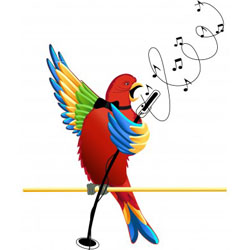 Music has a profound effect on our emotions as evidenced by its ability to transport us in time via our memories as well as to move us to tears or joyfulness. Depending on what we listen to, music can be calming and soothing or it can be energizing.
Music has a profound effect on our emotions as evidenced by its ability to transport us in time via our memories as well as to move us to tears or joyfulness. Depending on what we listen to, music can be calming and soothing or it can be energizing.
Music is a universal language understood by people from all cultures with the power to bring us together in a shared experience.
No one can tell for sure if animals perceive and experience music the same as humans do.
Researchers have started looking into the musical ability of animals. Whales and certain bird species are two examples of animals noted to posses the ability to compose complex songs complete with pitch relationships, rhythms and patterns.
It is known that music has the ability to relieve stress and anxiety in animals. Music is often used to calm dogs in kennels or those left alone at home. Harp music has also been observed to lower the heart rates, anxiety and respiration in hospitalized dogs.
Moving rhythmically to a musical beat is common to every human culture. Recently, interest has grown in determining whether beat perception and synchronization (e.g., dance) is a phenomenon that extends into the animal kingdom. Of particular interest is the study done by Aniruddh Patel from the Neurosciences Institute of California. After seeing the video of Snowball dancing to the Backstreet Boys he contacted Snowball's owner and made arrangements to have Snowball videotaped to his favorite music track played at different tempos (106 to 130 beats per minute). Patel then analyzed the videos to determine whether Snowball's movements were just a matter of chance or if Snowball truly possessed the ability to synchronize his body movements to the rhythm of the music. The results of the study clearly demonstrated that Snowball can dance. Go Snowball!
Patel states that the ability to dance is associated with the vocal learning abilities of a particular species. Humans and parrots are two of the very few species with brains wired for vocal learning (the ability to remember and reproduce sounds they hear). Besides humans, only elephants, bats, whales, dolphins and three orders of birds (parrots, songbirds and hummingbirds) possess vocal learning abilities. No non-human primates have ever demonstrated this ability!
So, what does all of this mean relative to our desire to enrich the lives of our pet birds? We can begin by:
- Observing our bird's body language and behavior while playing various styles of music to determine what they like, what calms them, what excites them, etc.
- Providing numerous opportunities for auditory sensory stimulation as part of our household's daily enrichment routine.
- Sharing the gift of song, music and dance with our birds. Singing and dancing with our birds, a type of interactive play, is both mentally and physically stimulating not to mention a great bonding activity. Before you know it you might find your bird joining the chorus.
Just as music and dance add joy to our lives, the evidence is in that it enhances the lives of our pet birds as well. So go ahead, pick up your bird and sing and dance as though no one else is watching.
Write comment (0 Comments)- Written by: Maggie Wright
- Category: Mental Stimulation
 Birds learn to talk in order to communicate their needs; and once they understand the "power" of their words, the fact that they can get what they want by talking, many of them will learn to talk. Most of us cannot teach our birds exactly like Alex because 1) first, we do not have the time and 2) secondly, we do not always have partners that are free to help us conduct Model/Rival techniques. However, we can use some of the principles from the M/R system and assimilate them into an easier system for the "average" pet human, which we already know is well below the "average" African Grey Master! Nevertheless, this is what I shall attempt in this article.
Birds learn to talk in order to communicate their needs; and once they understand the "power" of their words, the fact that they can get what they want by talking, many of them will learn to talk. Most of us cannot teach our birds exactly like Alex because 1) first, we do not have the time and 2) secondly, we do not always have partners that are free to help us conduct Model/Rival techniques. However, we can use some of the principles from the M/R system and assimilate them into an easier system for the "average" pet human, which we already know is well below the "average" African Grey Master! Nevertheless, this is what I shall attempt in this article.
WHAT MADE ALEX LEARN?
First of all, we know that all wild birds learn their vocalizations by copying their parents and other flock members. They watch, they listen and they practice. They learn by socially interacting with their parental teachers. Similarly, Alex's trainers provided "Full Social Interaction" by interacting with him in the room, showing and demonstrating the object that he was learning to label and then giving him the object when he correctly labeled it.
Secondly, Alex was given the exact object that he was learning to label, which taught him that there was a direct relationship between the word and the three-dimensional object. He was able to "beak" it, to hold it, and to chew it. This is called "Reference," or learning the "meaning of the label."
Third, Alex was taught the "power" of words by requesting objects. In other words, he was taught their "Function" and how they were applicable to him. Once he learned to say, "Want paper," and the paper was given to him, he learned that he could obtain the object, if he said the correct word.
The Model/Rival system utilized two human trainers to socially interact with Alex. One person was the trainer and the other person was the model, after whom Alex was supposed to act, as well as his rival for the attentions of the trainer. We all know that Greys, and most parrots, can be "manipulative" and "competitive" for the attentions of their preferred humans, and the model/rival system does accentuate these two qualities.
On top of that, the trainer and model/rival switched roles where the trainer then became the model/rival to Alex and the model/rival became the trainer. This very important aspect taught Alex that he could also ask questions, which helped him learn to interact, rather than only repeat one part of the exchange.
Sessions were usually no longer than 20 minutes, sometimes daily and sometimes not at all, depending on the moods of Alex and the activities transpiring in his lab bird-room. Practice and social interactions were also important where much of the time, Alex was in full charge, ordering the student trainers and lab manager to fetch and do things for him. 'Want pa," he said, and he was brought pasta. "Want chair," and he was taken to the chair. "Want to go back!" and he was taken to his cage. "Want chair," and he was taken back to the chair. "Want showaa!" and he was given a spritz. "Want to go back," and he was taken back to the cage. Now, if I were an African Grey parrot, this would be heaven for me!
Alex was one special soul who took advantage of all of these aspects to prove far and beyond what anyone could ever imagine that a parrot with a walnut-sized brain could do. But I think there was one more key aspect that helped him do it. He was treated with respect as an associate by Dr. Pepperberg, and he was a part of the team that kept breaking through the barriers. I can imagine how exhilarated everyone must have felt every time that Alex learned to name paper..... to identify colors...to identify that there was no difference between objects...to identify numbers......to come up with his own concept of zero......to add numbers on his own, just to name a few accomplishments. Exhilaration, praise and respect build confidence and the combination thereof can help us do the impossible. That's why Alex was known as that "Damn bird!" by many scientists because he always proved them wrong....he showed them that an animal with bird-brains could actually think!
TRANSFERRING SOME OF THESE TECHNIQUES INTO OUR HOMES
We must remember that the focus of Alex's work was primarily on building cognition, instead of being taught how to speak English. Dr. Pepperberg had always claimed that Alex was taught an "English-based language-like code" instead of a true language that incorporates syntactic grammar. For example, he was taught short phrases, such as "Want Pa," instead of "I want my pasta treat." Therefore, he did not hold the "world's record" for knowing the most words or for speaking correct English; but he was the world's foremost African Grey scholar, working on his PhD for 30 years!
Most of us pet humans do not have the time to dedicate to help our birds truly develop Alex-level cognitive abilities; however, we can help them learn to communicate and interact within our human households. Therefore, our focus on teaching our birds could take on some of the techniques of Alex's training, but our emphasis should be more focused on our language-interaction with them, while at the same time, bringing in some of the aspects of the Model/Rival system to help provide the dimension of understanding, instead of mimicking.
The first step is to place your bird in a "socially interactive" environment, which means that we should have them with us in the family room, interacting with the family as much as possible, instead of spending most of their time in a bird room where they only learn to mimic language phrases without having any understanding of their meaning and purpose. This is where the "full social interaction" part of the Alex Pepperberg training comes in.
Secondly, include your bird in your conversations and talk about everything. Explain everything that you are doing, and explain to your bird what you will be doing with him, before you do it, such as taking him out of the cage.
In the beginning, place first emphasis on "action concepts," such as going to the perch, going to the window or requesting specific food. This provides the functionality, thus giving the bird a reason to want to learn the particular action concepts because it gives him "power" over his environment so that he can communicate his wants and needs.
Let's take the action of learning to request the perch. Talk about taking your bird to his perch in a few different sentences, always placing the name of the object at the end because birds and humans tend to remember the word at the end of a sentence. This is called "sentence framing."
- "Do you want to go to your perch?"
- "I'll take you to your perch."
- "It's a pretty green perch!"
- "Let's go to the perch. Up, up."
- "Here's the perch. Get onto the perch. Down. Good boy!"
Observe your bird and study what seems to interest him, and then talk a lot about that. For example, if he loves to watch the crows outside, sit with him by the window and talk about the crows with him. Again, do this in a sentence framing way where you place the word "crow" at the end of every sentence.
Every time that your bird says any word, give that object to him, whether or not you are trying to teach it to him. If you are trying to teach "perch," but instead, he says "water," bring him the water and then talk about it. I remember when I was first teaching Merlin to request various foods, I found myself scrambling. Every time that she requested apple, for example, I had to rush over to give her a piece of apple. Unfortunately, over time, I got lazy and did not force her to request the exact type of food every time, and so she now says "want some apple," which has become generic for "want some food."
Accordingly, every time your bird "copies" your phrases, make sure you answer back so that he learns that he can ask the questions too. For example, if he asks "Do you want some apple?" Go to the refrigerator and say, "Yes! I want some apple" and then eat the apple. Then talk about the "apple" in terms of "I" and then turn it around to "you" in terms of your bird.
Bird: "Do you want some apple?"
Pet human: Get piece of apple. "Yes! I want some apple. I love apple. Hmm, it's a yummy apple! Do you want some apple?"
Bird: "Apple." Or "aah-uhl"
Pet human: "Good bird!" Give him a piece of apple.
If you have a large household, encourage all members to interact with your bird verbally. Ask them to reverse roles, if they have time, so that your bird learns that everyone can interact by questioning and answering.
No matter what you are teaching your bird to label, be sure to give him the object to beak and chew, every time he either says the word or makes an attempt to do so. However, if it is food, please do not ever give your bird the same piece of food that you have put in your mouth because we have bacteria in our mouths that could make our birds seriously sick. Give him another piece of the food that you are teaching him to label.
MAKE LEARNING FUN
Again, enthusiasm and praise go a very long way. The more fun you are having while teaching your bird to talk, the more your bird will want to learn. This is the opportunity to be silly, act childlike (but do not use baby talk) and to actually have fun doing it.
My Merlin learned 7 animal sounds, and I taught her by first going with her interest. For example, she started to copy the bark of a friend's dog, and instead of getting upset, I turned it into a game. When Merlin barked, I asked "What does the doggie say?" Then every time that she barked right after I asked the question, I got so excited and praised her so much that it made her feel as if she had just won the lottery. Geez, wish she had! As a result, she learned to respond to my question with a bark.
Once we had the "what does the doggie say" Q&A down, I physically introduced her to the other animals that she learned to copy. Therefore, she knows that dogs, cats, roosters and ducks are other animals and what they look like: she was taught the reference, or the meaning of the words, dog and cat.
But getting into more serious learning matters, many pet humans utilize young children's learning boxes to teach their birds to talk. There are many good learning toys in Toys R Us and other toy stores that would be perfect teaching tools. When you shop for one, please also include safety as one of your requirements. Make sure there are not any buttons or switches or small objects that can be easily bitten off and swallowed, making your bird sick. Secondly, once you have found a good learning tool, you must first introduce it as a toy, which means very slowly. As with any new, strange toy, place it far away from the cage and play with it daily, acting joyous and excited about it, and eventually move it closer and closer to the cage. Do not ever place it in the cage until your bird is comfortable with it and wants to play with it. Play with it yourself as your bird would. For example, use your nose to act as a beak to punch buttons, which will teach your bird how to manipulate it.
TONALITY AND PHONETICS
Some parrots get so wrapped up in learning phrases that they do not practice so much on the tonality of their speech, which can result in a garbled sound that only you would recognize. Therefore, be sure to focus on helping your bird to speak the phrase that he is learning.
When I teach Merlin and Sweetpea, and now Kyo too, I sound out new words to them phonetically. For example, when teaching them "Merry Christmas," I would sound it out phonetically as: "Cr...Cr...Crr.. Cris.....mus. Cris...mus" and then I sounded out the word as it should be stated. At first, Merlin said, "Merry Christma," and so I had to emphasize the "mus" part at the end by saying "Christmus" quickly.
The positive about teaching in terms of phonetics is that it introduces sounds that the birds can play with. Merlin chooses different sounds that she wants to work on and then she combines them with other words that she has known, in order to make new ones. For example, she has been focusing on the "CH" sound lately, and she adds it to other words that I taught her as a young parrot, such as "ears.... Ch...ears....cheers!" Then I extend the "CH" sound with her and show her the meaning of other new words that she is learning to speak. For example, I say "ears...CH...Cheers" and act very bubbly and excited to show what cheers means. Then I say "air....CH...CH..air...chair!" and then I point to two or three different chairs, and sit on a few. Then I support this with sentence framing, such as "CH...air...chair. Look at the black chair. I sit on the chair. See the blue chair? CH...air...chair!"
All "talking birds" have the ability to speak phrases in human terms; however, some of them choose never to talk. This is not because they are not as smart, but possibly, they have found other ways to communicate with their humans and are not interested in the act of talking. Also, anecdotally, I have found that in the African Grey world, usually one specific bird in a "family flock," where there is more than one Grey, or other parrots, usually becomes the dominant talker and the other birds seem to acquiesce to the dominant or top talking bird of the flock.
Let's thank Alex and Dr. Pepperberg for showing us bird people that Greys, and other talking birds, do not mimic, but they can learn to communicate meaningfully when given the right tools and when treated with respect.
Copyright ©2008 Margaret T. Wright All Rights Reserved.
****************************
Maggie Wright is the author of the Barron's African Grey pet manual: African Grey Parrots: A Complete Pet Owner's Manual and Bringing Back The Magic. She is the creator and publisher of Nature's Corner® Magazine, she is owned by three beautiful African Grey parrots: Merlin Tewillager, Sweetpea and Kyaaro. Learn more at http://www.MaggieWright.net
Write comment (0 Comments)- Written by: Deb White
- Category: Mental Stimulation
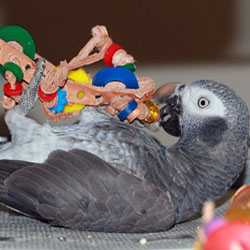 In the old days, parrots were just thought to be skillful mimics and where not given credit for the ability to learn and understand our language. To add further insult, the term Bird Brain was often used as a derogatory term towards individuals with, let's say, diminished brain capacity.
In the old days, parrots were just thought to be skillful mimics and where not given credit for the ability to learn and understand our language. To add further insult, the term Bird Brain was often used as a derogatory term towards individuals with, let's say, diminished brain capacity.
Birds do have a much smaller cerebral cortex, which is the main area of intelligence for most animals. However, it is now known that they use an entirely different part of their brain, the hyperstriatum, as their intelligence center.
Modern research has shown that parrots have an amazing brain and they are capable of much more than mere mimicry when it comes to language. Parrots also have been recognized for their memory of places and individuals as well as their ability to think, reason, solve problems, count, grasp abstract concepts, learn from example and to use and fashion tools.
To view some amazing segments about Alex check out these videos:
Studies continue to demonstrate that parrots have a higher level of intelligence than they have been given credit for. Most notably, Dr. Irene Pepperberg's work with African Grey parrots has revealed that parrots have the ability to:
- understand and appropriately respond to human language;
- think and reason;
- grasp the concepts of numbers, presence and absence, bigger and smaller and same and different;
- distinguish colors, shapes and materials;
- combine words in a meaningful fashion to form sentences; and,
- invent syntax (Alex named an almond in the shell a "cork nut" when he hadn't seen one before).
So, the next time someone calls you a Bird Brain, say "thanks for the compliment" !
Write comment (0 Comments)- Written by: Deb White
- Category: Mental Stimulation
 Scientists often refer to the use of tools as an indicator of intelligence within a species. Tools are defined as objects, other than a part of a bird's body, that are used for a useful purpose. Tool usage is an indicator of a species ability for inventive problem solving, flexibility of mind and their ability to learn and adapt.
Scientists often refer to the use of tools as an indicator of intelligence within a species. Tools are defined as objects, other than a part of a bird's body, that are used for a useful purpose. Tool usage is an indicator of a species ability for inventive problem solving, flexibility of mind and their ability to learn and adapt.
There have been many reports of tool usage by various species of birds. Darwin observed a finch in the Galapagos that fashioned a tool out of a twig to retrieve insects or larvae embedded inside branches. Crows in Japan commonly either place nuts under the tires of parked cars and return once the nuts are cracked or they position themselves on wires over a busy intersection and drop the nuts so that passing cars will crack them open.
There have been instances of tool usage reported in parrots as well. For example:
- Amazons, African Greys and Cockatoos have been noted to use objects to scratch the backs of their heads. (Check out the video of a parrot demonstrating tool use).
- Hyacinth Macaws have been reported to use pieces of wood inside their lower mandible to position palm nuts in such a manner that they are easier to crack (Hohenstein, 1987).
- Black Palm Cockatoos have been observed using a leaf inside their lower mandible to prevent the very hard kanara nuts from slipping when they try to crack them (The Malay Peninsula, Wallace, 1872).
- Black Palm Cockatoos are also well known for their "drumming" behavior whereby they use a stick to beat on a hollow limb or log (Wood, 1984). It is thought that this is a courtship behavior and the drumming is often accompanied by the spreading of wings, a raised crest, whistling call notes and a slow turning dance.
- An Eclectus in a zoo was reported to have been observed using a part of a palm leaf to scratch out a hollow for her eggs in the ground (The Minds of Birds; Alexander Skutch, 1996).
- Parrots have also been reported to use cups to dip water for drinking (The Minds of Birds; Alexander Skutch, 1996).
- Written by: Deb White
- Category: Mental Stimulation
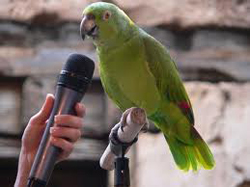 Due to their inherent intelligence, parrots have demonstrated the wonderful ability to “learn our language”. Much of this learning is done thru their intense observation of our interactions with other humans and household pets as well as our responses to certain situations such as a ringing phone or doorbell. Their ability to use complex and meaningful communication is one of the most enchanting aspects of these wonderful beings.
Due to their inherent intelligence, parrots have demonstrated the wonderful ability to “learn our language”. Much of this learning is done thru their intense observation of our interactions with other humans and household pets as well as our responses to certain situations such as a ringing phone or doorbell. Their ability to use complex and meaningful communication is one of the most enchanting aspects of these wonderful beings.
Teaching your bird to talk and sing can be accomplished by consistently applying language appropriate to what is going on in the house. Interaction, persistence, patience and most importantly, a good relationship with your bird, are key to teaching your bird to talk. A few more important points regarding speech training are:
- Speak clearly and repeat phrases.
- Conduct training in a quiet place free from competing distractions.
- Birds are naturally most vocal in the early morning and at sunset. They are more likely to learn if training is conducted at these times.
- Limit training sessions to 15-20 minutes twice a day.
- Start at as early an age as possible. Some species such as the African Grey are able to learn new words and phrases throughout their life but, for many species, the learning period effectively shuts down within the first few years of life.
- Birds have an appreciation for the dramatic. If you use emotion and enthusiasm in your speech it will catch their attention even more.
- Use praise and positive reinforcement liberally to acknowledge their attempts to communicate. The best reward for a parrot is always attention!
If you want your bird to learn to use language in a meaningful manner, it is important to speak in context to your bird. For example:
- Use names to consistently identify individuals and pets.
- Explain and talk about routine actions as they occur (i.e., feeding, cage cleaning, showers, scratches, bed time, etc).
- Birds learn best from observation of your interactions with other humans and animals. The model/rival technique has been employed by Dr. Irene Pepperberg in her interactions with Alex and other birds in her lab. Using this technique another human or bird "models" correct or incorrect responses to your questions and also serves as a rival for your attention during training.
Check out this video of a PBS segment with Alan Alda and Dr. Pepperberg demonstrating the model/rival method:
There are also many helpful products on the market to facilitate speech training.
If your bird doesn't learn to talk, don't stop trying to communicate. Not all birds will learn to talk but they still may be very capable of understanding some of our words as well as interpreting our tone and body language. Additionally, if we are astute students of their vocalizations and body language we may just notice that they are trying to communicate with us in other ways.
Write comment (0 Comments)- Written by: Deb White
- Category: Mental Stimulation
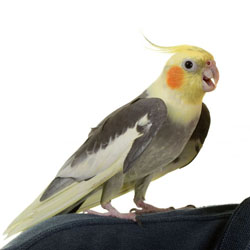 A parrot's ability to use and understand language is one of their most intriguing and endearing qualities. Parrots are unique in nature for their ability to use language. Other animals may have the capacity to learn and understand, for example chimpanzees and gorillas use of American Sign Language, but only parrots have the ability to speak to us in our own language.
A parrot's ability to use and understand language is one of their most intriguing and endearing qualities. Parrots are unique in nature for their ability to use language. Other animals may have the capacity to learn and understand, for example chimpanzees and gorillas use of American Sign Language, but only parrots have the ability to speak to us in our own language.
Why Do Parrots Talk?
Birds don't use human language in the wild but, they do speak in the language of the flock which they start to learn after fledging. Due to their highly social nature, parrots require communication to facilitate interaction within the flock. Living in our homes, we are their flock and their innate drive to exist within our social structure compels them to learn and use our language to get our attention.
How do Parrots Talk?
Birds do not have a larynx and vocal cords to facilitate speech....not to mention LIPS! In parrots, sounds are created by a pair of membranes in the sryinx which is located between the bottom of the windpipe (trachea) and the lungs. Different sounds are made when they change the shape and depth of the trachea. Recent studies at Indiana University have also indicated that the coordination of a parrot's beak and muscular tongue play a role in altering the sounds produced.
Write comment (0 Comments)

















































































































































